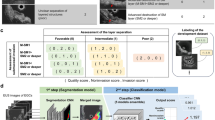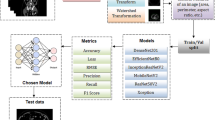Abstract
Purpose
Prostate cancer (PCa) imaging has been revolutionized by the introduction of multi-parametric Magnetic Resonance Imaging (mpMRI). Transrectal ultrasound (TRUS) has always been considered a low-performance modality. To overcome this, a computerized artificial neural network analysis (ANNA/C–TRUS) of the TRUS based on an artificial intelligence (AI) analysis has been proposed. Our aim was to evaluate the diagnostic performance of the ANNA/C-TRUS system and its ability to improve conventional TRUS in PCa diagnosis.
Methods
We retrospectively analyzed data from 64 patients with PCa and scheduled for radical prostatectomy who underwent TRUS followed by ANNA/C-TRUS analysis before the procedure. The results of ANNA/C-TRUS analysis with whole mount sections from final pathology.
Results
On a per-sectors analysis, sensitivity, specificity, negative predictive value (NPV), positive predictive value (PPV) and accuracy were 62%, 81%, 80%, 64% and 78% respectively. The values for the detection of clinically significant prostate cancer were 69%, 77%, 88%, 50% and 75%. The diagnostic values for high grade tumours were 70%, 74%, 91%, 41% and 74%, respectively. Cancer volume (≤ 0.5 or greater) did not influence the diagnostic performance of the ANNA/C-TRUS system.
Conclusions
ANNA/C-TRUS represents a promising diagnostic tool and application of AI for PCa diagnosis. It improves the ability of conventional TRUS to diagnose prostate cancer, preserving its simplicity and availability. Since it is an AI system, it does not hold the inter-observer variability nor a learning curve. Multicenter biopsy-based studies with the inclusion of an adequate number of patients are needed to confirm these results.


Similar content being viewed by others
References
Mottet N, van den Bergh RCN, Briers E et al (2021) EAU-EANM-ESTRO-ESUR-SIOG guidelines on prostate cancer-2020 update. Part 1: screening, diagnosis, and local treatment with curative intent. Eur Urol 79(2):243–262. https://doi.org/10.1016/j.eururo.2020.09.042
Beemsterboer PM, Kranse R, de Koning HJ, Habbema JD, Schröder FH (1999) Changing role of 3 screening modalities in the European randomized study of screening for prostate cancer (Rotterdam). Int J Cancer 84:437–441. https://doi.org/10.1002/(SICI)1097-0215(19990820)84:4%3c437::AID-IJC19%3e3.0.CO;2-S
Loch T, Leuschner I, Genberg C, Weichert-Jacobsen K, Küppers F, Yfantis E, Evans M, Tsarev V, Stöckle M (1999) Artificial neural network analysis (ANNA) of prostatic transrectal ultrasound. Prostate 39(3):198–204. https://doi.org/10.1002/(SICI)1097-0045(19990515)39:3%3c198::AID-PROS8%3e3.0.CO;2-X
Loch T, Leuschner I, Genberg C, Weichert-Jacobsen K, Küppers F, Retz M, Lehmann J, Yfantis E, Evans M, Tsarev V, Stöckle M (2000) Weiterentwicklung des transrektalen Ultraschalls. Artifizielle neuronale Netzwerkanalyse (ANNA) in der Erkennung und Stadieneinteilung des Prostatakarzinoms [Improvement of transrectal ultrasound. Artificial neural network analysis (ANNA) in detection and staging of prostatic carcinoma]. Urologe A 39(4):341–347. https://doi.org/10.1007/s001200050367
Ahmed HU, El-Shater Bosaily A, Brown LC, Gabe R, Kaplan R, Parmar MK, Collaco-Moraes Y, Ward K, Hindley RG, Freeman A, Kirkham AP, Oldroyd R, Parker C, Emberton M, PROMIS study group (2017) Diagnostic accuracy of multi-parametric MRI and TRUS biopsy in prostate cancer (PROMIS): a paired validating confirmatory study. Lancet 389(10071):815–822. https://doi.org/10.1016/S0140-6736(16)32401-1
Kasivisvanathan V, Rannikko AS, Borghi M, Panebianco V, Mynderse LA, Vaarala MH, Briganti A, Budäus L, Hellawell G, Hindley RG, Roobol MJ, Eggener S, Ghei M, Villers A, Bladou F, Villeirs GM, Virdi J, Boxler S, Robert G, Singh PB, Venderink W, Hadaschik BA, Ruffion A, Hu JC, Margolis D, Crouzet S, Klotz L, Taneja SS, Pinto P, Gill I, Allen C, Giganti F, Freeman A, Morris S, Punwani S, Williams NR, Brew-Graves C, Deeks J, Takwoingi Y, Emberton M, Moore CM, PRECISION Study Group Collaborators (2018) MRI-targeted or standard biopsy for prostate-cancer diagnosis. N Engl J Med 378(19):1767–1777. https://doi.org/10.1056/NEJMoa1801993
Correas JM, Halpern EJ, Barr RG, Ghai S, Walz J, Bodard S, Dariane C, de la Rosette J (2021) Advanced ultrasound in the diagnosis of prostate cancer. World J Urol 39(3):661–676. https://doi.org/10.1007/s00345-020-03193-0
Mansfield P, Maudsley AA (1977) Medical imaging by NMR. Br J Radiol 50(591):188–194. https://doi.org/10.1259/0007-1285-50-591-188
Dussik KT (1954) The ultrasonic field as a medical tool. Am J Phys Med 33:5–20 (PMID: 13124475)
Van Booven DJ, Kuchakulla M, Pai R, Frech FS, Ramasahayam R, Reddy P, Parmar M, Ramasamy R, Arora H (2021) A systematic review of artificial intelligence in prostate cancer. Res Rep Urol 22(13):31–39. https://doi.org/10.2147/RRU.S268596
Hu X, Cammann H, Meyer HA, Miller K, Jung K, Stephan C (2013) Artificial neural networks and prostate cancer—tools for diagnosis and management. Nat Rev Urol 10(3):174–182. https://doi.org/10.1038/nrurol.2013.9
Ronco AL, Fernández R (1999) Improving ultrasonographic diagnosis of prostate cancer with neural networks. Ultrasound Med Biol 25(5):729–733. https://doi.org/10.1016/S0301-5629(99)00011-3
Tokas T, Grabski B, Paul U, Bäurle L, Loch T (2018) A 12-year follow-up of ANNA/C-TRUS image-targeted biopsies in patients suspicious for prostate cancer. World J Urol 36(5):699–704. https://doi.org/10.1007/s00345-017-2160-z
Harland N, Russo GI, Kaufmann S, Amend B, Rausch S, Erne E, Scharpf M, Nikolaou K, Stenzl A, Bedke J, Kruck S (2022) Robotic transrectal computed tomographic ultrasound with artificial neural network analysis: first validation and comparison with MRI-guided biopsies and radical prostatectomy. Urol Int 106(1):90–96. https://doi.org/10.1159/000517674
Müller S, Lilleaasen G, Sand TE, Løfsgaard L, Estop-Garanto M, Helgø D, Sund P, Mygland V (2018) Poor reproducibility of PIRADS score in two multiparametric MRIs before biopsy in men with elevated PSA. World J Urol 36(5):687–691. https://doi.org/10.1007/s00345-018-2252-4
Sonn GA, Fan RE, Ghanouni P, Wang NN, Brooks JD, Loening AM, Daniel BL, To’o KJ, Thong AE, Leppert JT (2019) Prostate magnetic resonance imaging interpretation varies substantially across radiologists. Eur Urol Focus 5(4):592–599. https://doi.org/10.1016/j.euf.2017.11.010
Fehr D, Veeraraghavan H, Wibmer A, Gondo T, Matsumoto K, Vargas HA, Sala E, Hricak H, Deasy JO (2015) Automatic classification of prostate cancer Gleason scores from multiparametric magnetic resonance images. Proc Natl Acad Sci U S A 112(46):E6265–E6273. https://doi.org/10.1073/pnas.1505935112
Antonelli M, Johnston EW, Dikaios N, Cheung KK, Sidhu HS, Appayya MB, Giganti F, Simmons LAM, Freeman A, Allen C, Ahmed HU, Atkinson D, Ourselin S, Punwani S (2019) Machine learning classifiers can predict Gleason pattern 4 prostate cancer with greater accuracy than experienced radiologists. Eur Radiol 29(9):4754–4764. https://doi.org/10.1007/s00330-019-06244-2
Toivonen J, Montoya Perez I, Movahedi P, Merisaari H, Pesola M, Taimen P, Boström PJ, Pohjankukka J, Kiviniemi A, Pahikkala T, Aronen HJ, Jambor I (2019) Radiomics and machine learning of multisequence multiparametric prostate MRI: Towards improved non-invasive prostate cancer characterization. PLoS ONE 14(7):e0217702. https://doi.org/10.1371/journal.pone.0217702
Grey ADR, Connor MJ, Tam J, Loch T (2020) Can transrectal prostate ultrasound compete with multiparametric MRI in the detection of clinically significant prostate cancer? Transl Androl Urol 9(3):1492–1500. https://doi.org/10.21037/tau.2020.02.26
Grabski B, Baeurle L, Loch A, Wefer B, Paul U, Loch T (2011) Computerized transrectal ultrasound of the prostate in a multicenter setup (C-TRUS-MS): detection of cancer after multiple negative systematic random and in primary biopsies. World J Urol 29(5):573–579. https://doi.org/10.1007/s00345-011-0713-0
Strunk T, Decker G, Willinek W, Mueller SC, Rogenhofer S (2014) Combination of C-TRUS with multiparametric MRI: potential for improving detection of prostate cancer. World J Urol 32(2):335–339. https://doi.org/10.1007/s00345-012-0924-z
Acknowledgements
The authors thank all the staff of the Oncologic Surgery Division 2 of Institut Paoli-Calmettes Cancer Center, Laetitia Michel, Manon Rinaldo, Sophia Anane and Hadhirami Ibouroi for their help in the everyday practice.
Author information
Authors and Affiliations
Contributions
VL: Protocol, Data collection or management, Data analysis, Manuscript writing. BK: project development, Data analysis. GP: Data collection, Manuscript editing. NB: Data collection, Manuscript editing. AP: Data collection. JTP: Manuscript review. SB: Coordination, Manuscript review. NN: Coordination. GM: Coordination. NS: Coordination, Manuscript editing. EM: Coordination. ODC: Coordination. GG: Manuscript editing. JW: Protocol/project development, Data analysis, Manuscript concept, Coordination.
Corresponding author
Ethics declarations
Conflict of interest
JW declares the following conflicts of interest: Hitachi, Supersonic, ANNA/C-TRUS, 3D-Biopsy, Exact imaging. ANNA/C-TRUS provided image data analysis for research purposes for this study. All other authors declare that they have no conflict of interest.
Ethical approval
All procedures performed in studies involving human participants were in accordance with the Ethical Standards of the Institutional and/or National Research Committee and with the 1964 Helsinki Declaration and its later amendments or comparable ethical standards.
Additional information
Publisher's Note
Springer Nature remains neutral with regard to jurisdictional claims in published maps and institutional affiliations.
Supplementary Information
Below is the link to the electronic supplementary material.
Rights and permissions
About this article
Cite this article
Lorusso, V., Kabre, B., Pignot, G. et al. External validation of the computerized analysis of TRUS of the prostate with the ANNA/C-TRUS system: a potential role of artificial intelligence for improving prostate cancer detection. World J Urol 41, 619–625 (2023). https://doi.org/10.1007/s00345-022-03965-w
Received:
Accepted:
Published:
Issue Date:
DOI: https://doi.org/10.1007/s00345-022-03965-w




